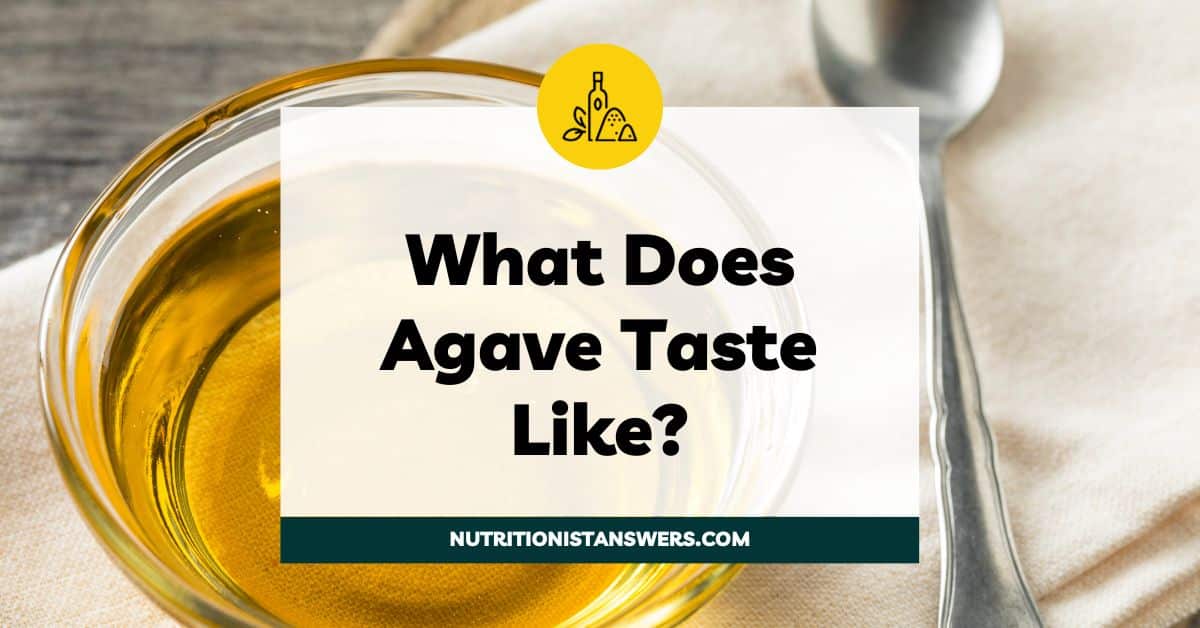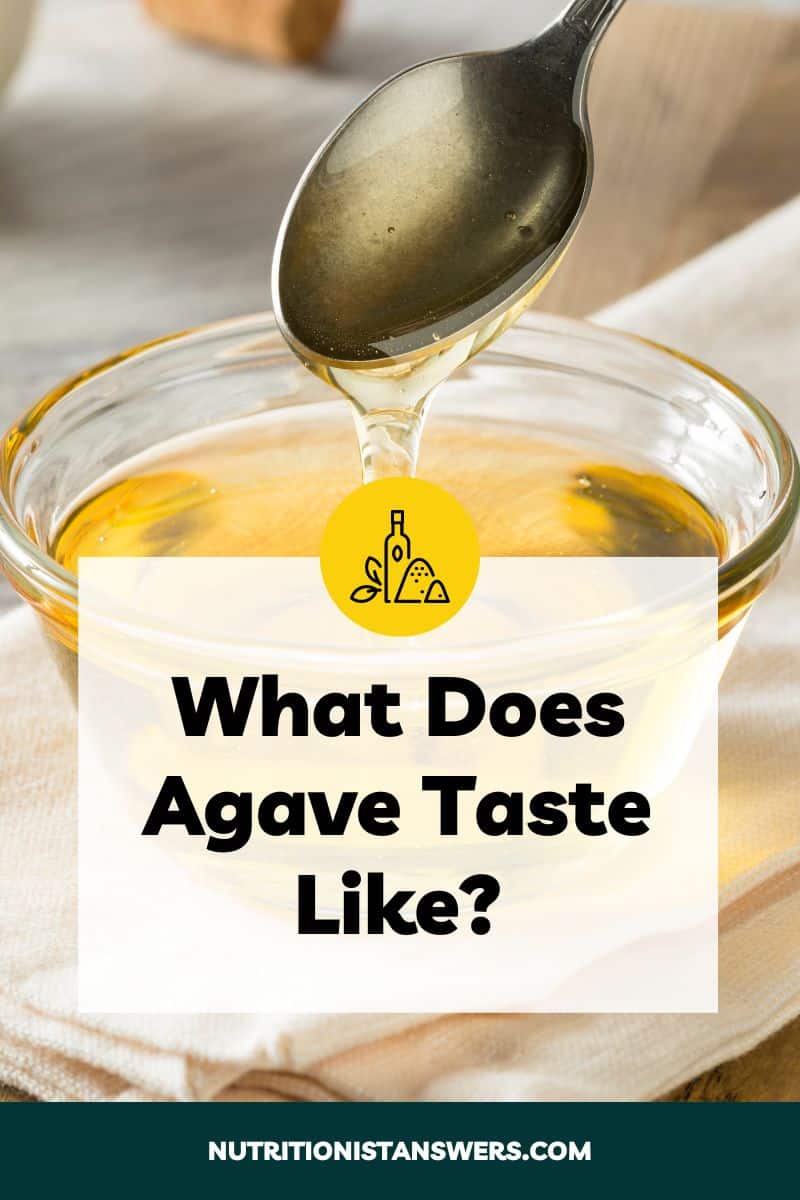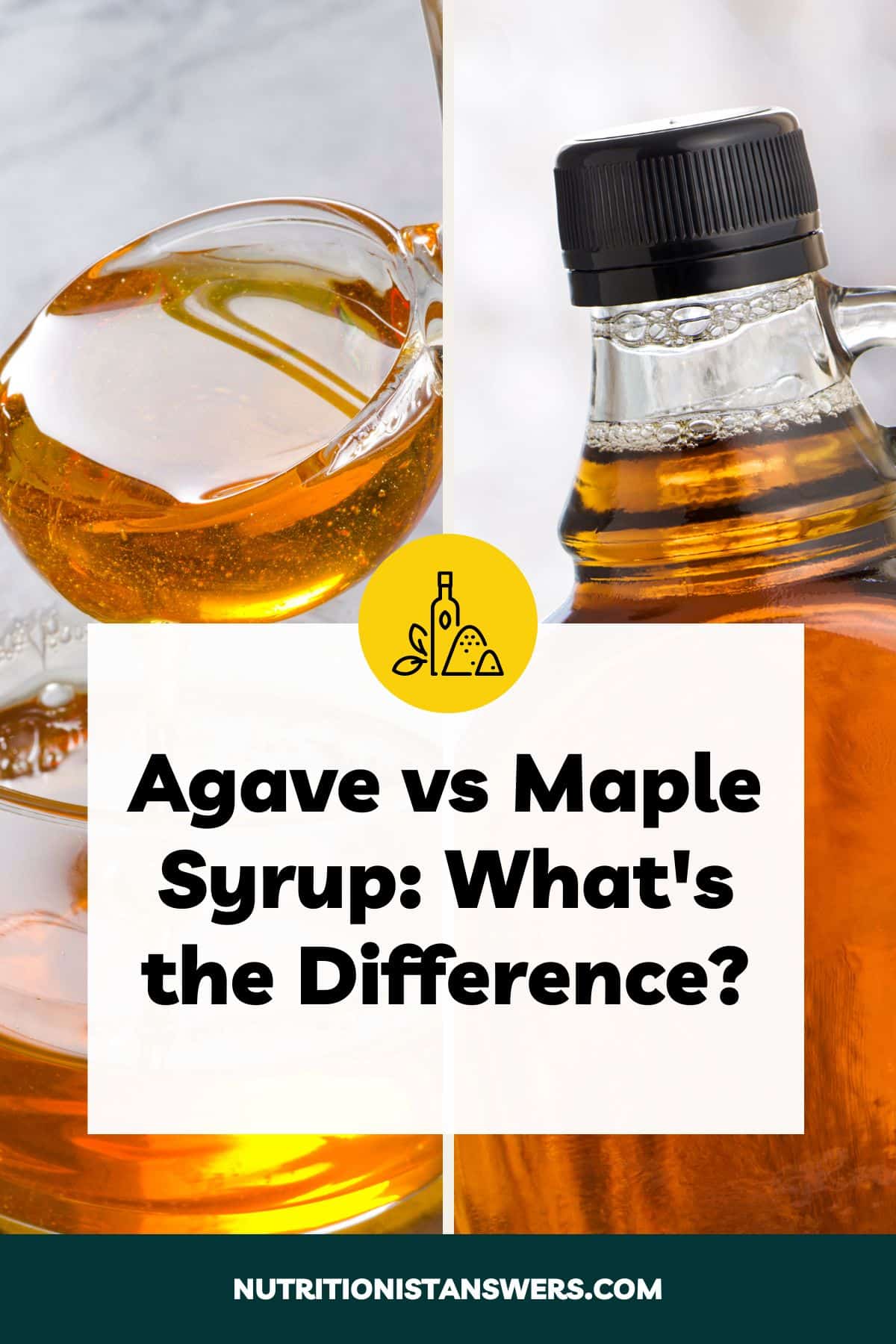Agave syrup has gained popularity as a natural sweetener, cherished for its potential health benefits and versatility in the kitchen.
But what sets agave apart from other sweeteners, and what exactly does it taste like?
Let’s delve into the distinct flavor profile of agave, its nutritional value, and why it’s become a favorite among health-conscious consumers and culinary enthusiasts.

Please note that this article contains affiliate links. If you click one of these links and make a purchase, we may earn a commission. As an Amazon Associate, we earn from qualifying purchases.
What is agave nectar?
Agave nectar, also referred to as agave syrup, is a natural sweetener derived from the agave plant, which originated in Mexico and grows in the desert regions of Central and North America (1).
Agave plants have spiky, blue-green leaves that form a rosette shape and can grow to be 6 feet tall. Their pineapple-shaped cores (also called the piñas) grow underground (2).
To make agave nectar, sap is collected from the agave’s core, then filtered and heated or processed with enzymes to convert the fructans (a type of complex carbohydrate) into sugars.
The end result is a sweet, amber-colored syrup that can be drizzled over pancakes, dissolved into beverages, or used to replace table sugar in baked goods and other dishes.
What does agave taste like?
Agave tastes very sweet and has a mild flavor with caramel undertones.
Lighter types of agave tend to have a more neutral flavor, while darker agave has a stronger, more distinct flavor.
Agave is 1.5x sweeter than table sugar due to its high fructose content. Agave is also sweeter than honey and corn syrup (3, 4).
Does agave taste like maple syrup?
Agave syrup has a milder, neutral sweetness with a hint of caramel, while maple syrup offers a richer, more distinct maple flavor. Both have a relatively thin and pourable consistency, similar to simple syrup.
Want to learn more about the differences between these sweeteners? Check out our article on agave vs maple syrup.
Does agave taste like honey?
Agave syrup has a lighter, milder flavor, whereas honey offers a richer, more complex taste with floral or fruity undertones.
The consistency of agave is typically thinner than honey, which tends to be thick and sticky.
Different types of agave
Agave comes in many different types, which can be classified based on their color, how they are processed, and which variety of agave is used:
- Light agave nectar is thoroughly filtered to remove many of the compounds that give agave its amber color and flavor (5).
- Amber (or dark) agave nectar is less filtered and therefore contains more of the compounds (including antioxidants) found naturally in agave (5).
- Raw agave nectar is heated at lower temperatures in an effort to preserve more of the natural compounds in agave (1, 6).
- Blue agave nectar is made exclusively from the blue agave plant (Agave tequilana), a variety grown in Mexico that is also used to make tequila (1).
Agave nutrition
Agave is high in carbohydrates and calories but contains no fiber, protein, or fat.
Here’s a more detailed breakdown of agave nutrition:
Calories and macronutrients
Here’s the macronutrient content for one tablespoon (21 grams) of agave syrup (7):
- Calories: 64
- Carbohydrates: 16 grams
- Fiber: 0 grams
- Protein: 0 grams
- Fat: 0 grams
All of the calories from agave come from carbohydrates. It does not contain any significant amounts of fiber, protein, or fat.
Vitamins and minerals
Here’s the vitamin and mineral content for one tablespoon (21 grams) of agave syrup (7):
- Vitamin C: 4 mg (4% DV)
- Vitamin K: 5 mcg (4% DV)
- Vitamin B6: 0.05 mg (3% DV)
- Thiamin: 0.02 mg (2% DV)
- Riboflavin: 0.03 mg (2% DV)
- Folate: 6 mcg (2% DV)
- Niacin: 0.1 mg (1% DV)
- Vitamin E: 0.2 mg (1% DV)
- Choline: 3 mg (1% DV)
- Selenium: 0.4 mcg (1% DV)
Agave syrup offers little nutritional value aside from sugars and calories. It provides less than 5% of the Daily Value (DV) for most vitamins and minerals per tablespoon.
Is agave healthier than other sweeteners?
Agave nectar is often marketed as a healthier alternative to table sugar and other sweeteners due to its low glycemic index.
Glycemic index measures how quickly a food raises blood sugar levels compared to pure glucose. Anything with a glycemic index of 55 or less is considered “low glycemic,” meaning that it causes a more gradual increase in blood sugar (8).
Agave’s glycemic index is 13, which is much lower than other sweeteners. For reference, table sugar has a glycemic index of 66 (9).
This makes agave an appealing option for people who want to sweeten their food while avoiding blood sugar spikes.
However, agave is very high in fructose, a type of sugar that has been linked with insulin resistance and liver disease when consumed in large amounts (10, 11).
There’s likely no reason to be concerned if you only use agave occasionally. But if you use it as your primary sweetener, you may want to reconsider.
Overall, agave syrup may be a healthier choice for anyone who needs to manage their blood sugar, as long as it is used in moderation.
Where to buy agave
Agave is available at most grocery stores and can be found in the baking aisle alongside other sweeteners, or in the natural foods section.
Additionally, you can purchase agave from online retailers, which may provide a wider selection of brands and types. Here are some agave products available on Amazon:
- 365 by Whole Foods Market Organic Raw Agave Nectar
- 365 by Whole Foods Market Organic Light Agave Nectar
- Agave In The Raw Organic Raw Blue Agave Nectar
- Agave In The Raw Organic Raw Light Agave Nectar
- Madhava Organic Amber Agave (100% Blue Agave)
- Madhava Organic Light Agave (100% Blue Agave)
How to store agave
Store agave in a cool, dark place, such as a pantry or cabinet, away from direct sunlight and heat sources. Make sure the lid is tightly closed after each use.
If stored properly, agave should stay fresh for at least two years. Throw agave away if you notice any unpleasant odors, mold, or bacterial growth.
Ways to use agave
As a sugar substitute, baking, salad dressings, beverages, sauces & marinades, with pancakes
1. Drizzled over breakfast foods
Dark agave, with its caramel-like flavor and syrupy consistency, is an excellent replacement for maple syrup, perfect for drizzling over pancakes, waffles, or French toast.
Light agave is a great option when you want to sweeten breakfast foods without adding much flavor. It can be blended into smoothies or stirred into yogurt and oatmeal bowls.
2. As a sugar replacement in baked goods
Many people use agave syrup as a sugar replacement to bring a natural sweetness to baked goods like breads, muffins, cookies, and cakes.
When swapping agave for table sugar, keep in mind that it’s about 1.5 times sweeter, so you can use less of it. You’ll also want to reduce the liquid content in your recipe by about 25%.
Baked goods made with agave may brown more quickly, so it can be helpful to set the oven to a slightly lower temperature to avoid overdoing it.
3. To sweeten drinks and cocktails
Agave dissolves easily in both cold and hot liquids, making it an excellent alternative to granulated sugar or simple syrup when sweetening beverages.
Light agave offers a subtle sweetness that won’t compete with other flavors in teas, lemonades, and cocktails like margaritas or mojitos.
On the other hand, amber agave introduces a hint of caramel and earthiness, making it an excellent match for bolder beverages like dark roast coffee and black tea.
4. In salad dressings and marinades
Agave is perfect for adding a hint of sweetness to your favorite salad dressings and marinades with its mild taste that complements other flavors rather than overwhelming them.
For a simple vinaigrette, combine 3 parts olive oil with 1 part apple cider vinegar, then sweeten to taste with agave syrup and whisk in other flavor enhancers like minced garlic and Dijon mustard.
Agave can also enhance marinades for meats, seafood, or tofu. Mixing it with soy sauce, garlic, and ginger creates a delightful sweet and savory marinade for grilling or roasting.
5. On glazed meats and roasted vegetables
You can take dishes like roasted meats and vegetables to the next level by using agave to add sweetness that complements their savory flavors.
Combine agave syrup with Dijon mustard, a splash of apple cider vinegar, and some herbs for a luscious glaze that transforms simple chicken into a mouthwatering dish.
Or, drizzle agave syrup over a medley of root vegetables like carrots, parsnips, and sweet potatoes, and then roast them to perfection.
Final thoughts
Agave nectar is a natural liquid sweetener with a sweet, mild flavor with undertones of caramel. Light agave has more of a neutral flavor, while dark (amber) agave has a stronger caramel flavor.
Often touted as a healthier alternative to table sugar, agave may be helpful for managing blood sugar due to its very low glycemic index of 13 (9).
However, agave is also high in sugars, most of which are fructose, which has been linked with insulin resistance and liver disease when consumed in large amounts (10, 11).
Overall, agave syrup may be a healthier choice for people with diabetes or anyone who wants to lower their blood sugar levels, as long as it is used in moderation.
Amy Richter is a Registered Dietitian Nutritionist based in Missouri. She is an experienced nutrition writer and medical advisor for Healthline and Medical News Today. Amy is passionate about all things food-related and enjoys translating complex science into easy-to-understand articles.



